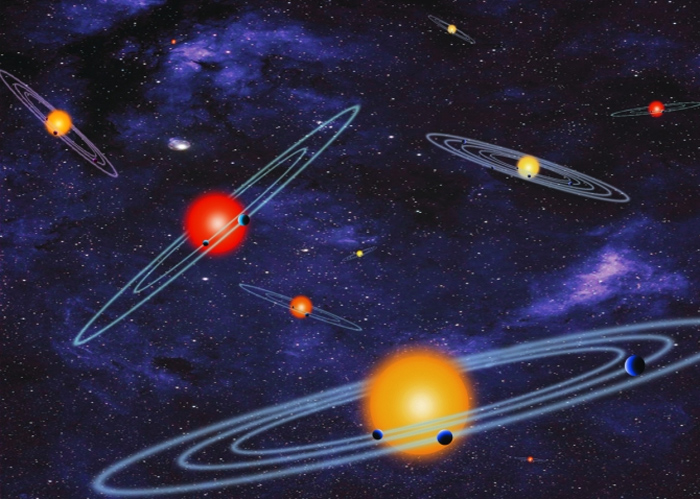NASA's Kepler Mission Announces a Planet Bonanza, 715 New Worlds
Education 조회 수 5242 추천 수 0 2014.02.28 08:48:09
NASA's Kepler mission announced Wednesday the discovery of 715 new planets. These newly-verified worlds orbit 305 stars, revealing multiple-planet systems much like our own solar system.
Nearly 95 percent of these planets are smaller than Neptune, which is almost four times the size of Earth. This discovery marks a significant increase in the number of known small-sized planets more akin to Earth than previously identified exoplanets, which are planets outside our solar system.
"The Kepler team continues to amaze and excite us with their planet hunting results," said John Grunsfeld, associate administrator for NASA's Science Mission Directorate in Washington. "That these new planets and solar systems look somewhat like our own, portends a great future when we have the James Webb Space Telescope in space to characterize the new worlds.”
Since the discovery of the first planets outside our solar system roughly two decades ago, verification has been a laborious planet-by-planet process. Now, scientists have a statistical technique that can be applied to many planets at once when they are found in systems that harbor more than one planet around the same star.
To verify this bounty of planets, a research team co-led by Jack Lissauer, planetary scientist at NASA's Ames Research Center in Moffett Field, Calif., analyzed stars with more than one potential planet, all of which were detected in the first two years of Kepler's observations -- May 2009 to March 2011.
The research team used a technique called verification by multiplicity, which relies in part on the logic of probability. Kepler observes 150,000 stars, and has found a few thousand of those to have planet candidates. If the candidates were randomly distributed among Kepler's stars, only a handful would have more than one planet candidate. However, Kepler observed hundreds of stars that have multiple planet candidates. Through a careful study of this sample, these 715 new planets were verified.
This method can be likened to the behavior we know of lions and lionesses. In our imaginary savannah, the lions are the Kepler stars and the lionesses are the planet candidates. The lionesses would sometimes be observed grouped together whereas lions tend to roam on their own. If you see two lions it could be a lion and a lioness or it could be two lions. But if more than two large felines are gathered, then it is very likely to be a lion and his pride. Thus, through multiplicity the lioness can be reliably identified in much the same way multiple planet candidates can be found around the same star.
"Four years ago, Kepler began a string of announcements of first hundreds, then thousands, of planet candidates --but they were only candidate worlds," said Lissauer. "We've now developed a process to verify multiple planet candidates in bulk to deliver planets wholesale, and have used it to unveil a veritable bonanza of new worlds."
These multiple-planet systems are fertile grounds for studying individual planets and the configuration of planetary neighborhoods. This provides clues to planet formation.
Four of these new planets are less than 2.5 times the size of Earth and orbit in their sun's habitable zone, defined as the range of distance from a star where the surface temperature of an orbiting planet may be suitable for life-giving liquid water.
One of these new habitable zone planets, called Kepler-296f, orbits a star half the size and 5 percent as bright as our sun. Kepler-296f is twice the size of Earth, but scientists do not know whether the planet is a gaseous world, with a thick hydrogen-helium envelope, or it is a water world surrounded by a deep ocean.
"From this study we learn planets in these multi-systems are small and their orbits are flat and circular -- resembling pancakes -- not your classical view of an atom," said Jason Rowe, research scientist at the SETI Institute in Mountain View, Calif., and co-leader of the research. "The more we explore the more we find familiar traces of ourselves amongst the stars that remind us of home."
This latest discovery brings the confirmed count of planets outside our solar system to nearly 1,700. As we continue to reach toward the stars, each discovery brings us one step closer to a more accurate understanding of our place in the galaxy.
Launched in March 2009, Kepler is the first NASA mission to find potentially habitable Earth-size planets. Discoveries include more than 3,600 planet candidates, of which 961 have been verified as bona-fide worlds.
The findings papers will be published March 10 in The Astrophysical Journal and are available for download at:
http://www.nasa.gov/ames/kepler/digital-press-kit-kepler-planet-bonanza
Ames is responsible for the Kepler mission concept, ground system development, mission operations and science data analysis. NASA's Jet Propulsion Laboratory in Pasadena, Calif., managed Kepler mission development. Ball Aerospace & Technologies Corp. in Boulder, Colo., developed the Kepler flight system and supports mission operations with the Laboratory for Atmospheric and Space Physics at the University of Colorado in Boulder. The Space Telescope Science Institute in Baltimore archives, hosts and distributes Kepler science data. Kepler is NASA's 10th Discovery Mission and was funded by the agency's Science Mission Directorate.
For more information about the Kepler space telescope, visit:
Michele Johnson
Ames Research Center, Moffett Field, Calif.
650-604-6982
michele.johnson@nasa.gov
J.D. Harrington
Headquarters, Washington
202-358-5241
j.d.harrington@nasa.gov
